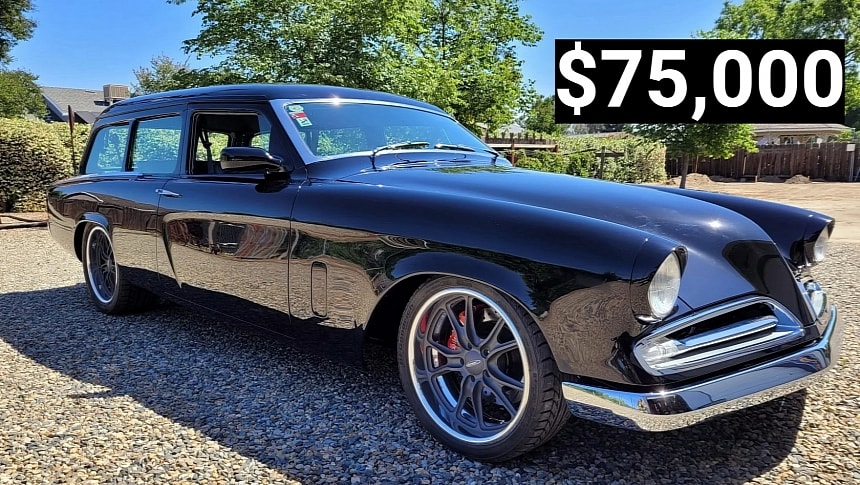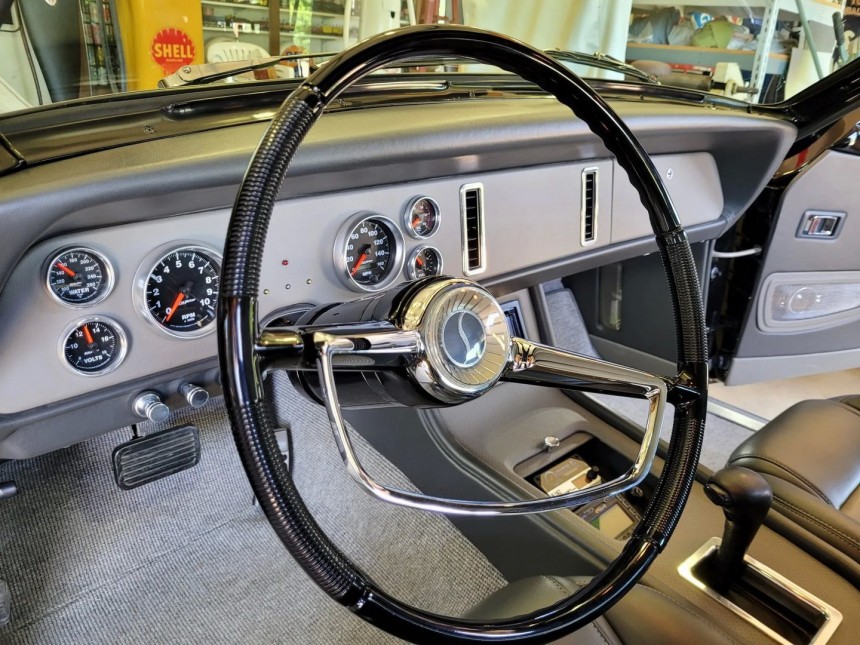Before the age of muscle cars, big coupes and pillared two-door sedans reigned supreme. Among them, the likes of the Studebaker Starlight Coupe stood out thanks to its hood-like trunk cover, with people joking that you could hardly tell whether it was coming or going. It also featured an interesting wrap-around rear window, in a time when rear-seat passengers were used to a little more... privacy.
In any case, the Starlight Coupe quickly caught on, and you had other carmakers copying their design too. Now, you might not know it by looking at it, but this custom 1953 Studebaker Commander started life as a Starlight Coupe model before being turned into a modern V8-powered station wagon.
A lot of work went into this conversion, so the fact that it just sold for $75,000 comes as no surprise.
The first thing they did was add the roof section from a 1955 Commander (in fact, the coupe and wagon roofs are spliced together), before adding the electrically operated fender vents, a rear seat, spare tire well, upper and lower tailgates, plus sliding passenger windows. In the end, they brought everything together using a single-stage PPG Concept black hue, to go with the chrome and stainless-steel trim pieces.
Other highlights include the custom Ridetech air suspension, four-wheel Wilwood disc brakes with four-piston calipers, and a set of 18” Budnik wheels with 215/40 and 275/40 BFGoodrich g-Force Sport tires.
Moving on to the interior, you’ll find a predominantly gray upholstery, a 1958 Studebaker Hawk dashboard, custom center console, electric power steering, fifth-gen Mustang seats (nice addition), Vintage Air climate control, two-speed intermittent windshield wipers, LED lighting, custom carpeting, a Kenwood touchscreen stereo, aftermarket speakers, custom gauges and a two-spoke steering wheel sourced from a Lark (another, more compact Studebaker model).
Some really interesting things happen once you pop the hood, but that’s how you’ll come across a 5.0-liter Coyote V8 engine, borrowed from a 2013 Mustang GT (I assume they also used it as the donor car for those seats). It’s got titanium-coated headers, custom exhaust system with 2.5” stainless steel piping and Dynomax mufflers, plus a four-speed 4R70W automatic transmission sourced from a 2003 Ford F-150.
In terms of muscle, you can assume that roughly 420 horsepower are being channeled to the wheels. This is undoubtedly a fast car. Maybe not Tesla Plaid fast, like the kids are used to these days, but certainly fast enough for 99% of drivers, especially people used to driving classic cars.
Now that’s what I call a monster.
A lot of work went into this conversion, so the fact that it just sold for $75,000 comes as no surprise.
The first thing they did was add the roof section from a 1955 Commander (in fact, the coupe and wagon roofs are spliced together), before adding the electrically operated fender vents, a rear seat, spare tire well, upper and lower tailgates, plus sliding passenger windows. In the end, they brought everything together using a single-stage PPG Concept black hue, to go with the chrome and stainless-steel trim pieces.
Other highlights include the custom Ridetech air suspension, four-wheel Wilwood disc brakes with four-piston calipers, and a set of 18” Budnik wheels with 215/40 and 275/40 BFGoodrich g-Force Sport tires.
Moving on to the interior, you’ll find a predominantly gray upholstery, a 1958 Studebaker Hawk dashboard, custom center console, electric power steering, fifth-gen Mustang seats (nice addition), Vintage Air climate control, two-speed intermittent windshield wipers, LED lighting, custom carpeting, a Kenwood touchscreen stereo, aftermarket speakers, custom gauges and a two-spoke steering wheel sourced from a Lark (another, more compact Studebaker model).
In terms of muscle, you can assume that roughly 420 horsepower are being channeled to the wheels. This is undoubtedly a fast car. Maybe not Tesla Plaid fast, like the kids are used to these days, but certainly fast enough for 99% of drivers, especially people used to driving classic cars.
Show me an even bigger “Stud”
Don’t mind if I do, because I’m still not over this custom 1953 Studebaker Champion Regal Starliner, which sold at auction last year for just $26,000. It may not be as intriguing or as clean as this Commander Station Wagon, but it did come with a replacement 392 ci Hemi V8, rocking a Weiand supercharger and dual Holley Quick Fuel carburetors, sending 800 or so horsepower to the rear wheels.Now that’s what I call a monster.





















